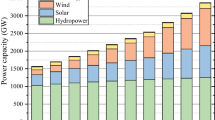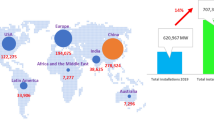Abstract
A new method of evaluating the degradation of wind turbine power performance was investigated on Jeju Island, South Korea in compliance with IEC international standards. Evaluating wind turbine degradation fairly within a year is difficult because wind speed varies annually. Thus, three wind turbines on the Hankyeong wind farm were tested to obtain the Nacelle power curves (NPCs) for a period of six years (from 2008 to 2013). The terrain of the wind farm was assessed; furthermore, an 80-m met mast was analyzed along with the nacelle wind speed within the measurement sector to determine the Nacelle transfer function (NTF). Six years of NPCs were determined with the NTFs. On the basis of these curves, each Capacity factor (CF) of the turbines was calculated by applying wind and electric power data derived from the SCADA system. These calculations were compared with the conventional normalized CF. The degradation of the normalized CF was approximately 0.26% per year on average based on the NPCs for the three wind turbines; this degradation was roughly 1.1% when the conventional approach was used.
Similar content being viewed by others
References
Wind Energy International 2014/2015, World Wind Energy Association (WWEA) (2013).
P. J. Tavner, J. Xiang and F. Spinato, Reliability analysis for wind turbines, Energy, 10 (1) (2007) 1–18.
L. Castro, A. Filgueira, M. A. Seijo, E. Munoz and L. Piegiari, Is it economically possible repowering wind farms, A general analysis in Spain, International Conference on Renewable Energies Power Quality (ICREPQ), 603 (2011).
R. Rodriguez, C. Rodriguez-Monroy, R. Rodriguez and F. Calvo, Analysis of renewable energy policies related to repowering the wind energy sector: the Spanish case, 11th Latin American and Caribbean Conference for Engineering and Technology 2013(LACCEI'2013), 104 (2013).
A. Graves, K. Harman, M. Wilkinson and R. Walker, Understanding availability trend of operation wind farms, Proc. of the Windpower 2008 Conference, Houston, Texas (2008).
N. Conroy, J. P. Deane and Brian P. Ó Gallachóir, Wind turbine availability should it be time or energy based?—a case study in Ireland, Renewable Energy, 36 (11) (2011) 2967–2971.
E. Migoya, A. Crespo, J. Garcia and F. Moreno, Comparative study of the behavior of wind-turbines in a wind farm, Energy, 32 (10) (2007) 1871–1885.
K. Y. Oh, J. Y. Kim, J. K. Lee, M. S. Ryu and J. S. Lee, An assessment of wind energy potential at the demonstration offshore wind farm in Korea, Energy, 46 (2012) 555–563.
H. C. Lim, Short-term observation of wind energy potentiality in the Wol-Ryong wind site, Journal of Mechanical Science and Technology, 26 (11) (2012) 3711–3721.
T. Üstüntas and A. Sahin, Wind turbine power curve estimation based on cluster center fuzzy logic modeling, Journal of Wind Engineering and Industrial Aerodynamics, 96 (5) (2008) 611–620.
F. Trivellato, L. Battisti and G. Miori, The ideal power curve of small wind turbines from field data, Journal of Wind Engineering and Industrial Aerodynamics, 107–108 (2012) 263–73.
S. Gill, B. Stephen and S. Galloway, Wind turbine condition assessment through power curve copula modeling, IEEE Trans Sustainable Energy, 3 (1) (2012) 94–101.
N. Murugan, Umamaheswari, S. I. Vimal and P. Sivashanmugam, Experimental investigation on power output in aged wind turbines, Advances in Mechanical Engineering (2012).
B. D. Altan and M. Atilgan, A study on increasing the performance of Savonius wind rotors, Journal of Mechanical Science and Technology, 26 (5) (2012) 1493–1499.
A. Curvers and P. A. van der Werff, OWEZ wind farm efficiency, NoordzeeWind (2009).
H. W. Kim, K. N. Ko and J. C. Huh, Wind turbine power performance testing using nacelle transfer function, Journal of the Korean Solar Energy Society, 33 (4) (2013) 51–58.
P. F. Bach, Capacity factor degradation for Danish wind turbines, Paul-Frederik Bach report, http://pfbach.dk/firma_pfb/pfb_capacity_factor_degradation_2012.pdf/ (2012).
J. Harrison, Viability of the algonquin power Amherst Island wind energy generating system, Association to protect Amherst Island, http://amherstislandwindinfo.com/aiw-docs/harrison-ai-viability-121115.pdf/ (2012).
G. Hughes, The performance of wind farms in the United Kingdom and Denmark, London: Renewable Energy Foundation, http://tinyurl.com/cn5qnqg/ (2012).
H. G. Kim, Analysis on wind turbine degradation of the Shinan wind power plant, Journal of the Korean Solar Energy Society, 33 (4) (2013) 46–50.
Staffell and R. Green, How does wind farm performance decline with age?, Renewable Energy, 66 (2014) 775–786.
IEC, Wind turbine generator systems Part 12-2: Power performance of electricity-producing wind turbines based on nacelle anemometry, First Ed., IEC 61400-12-2 (2013).
IEC, Wind turbine generator systems Part 12-1: Power performance measurements of electricity producing wind turbines, Third Ed., IEC 61400-12-1 (2005).
Author information
Authors and Affiliations
Corresponding author
Additional information
Recommended by Associate Editor Tong Seop Kim
Dongheon Shin is a Ph.D. candidate of the Multidisciplinary Graduate School Program for Wind Energy in Jeju University, Republic of Korea. He holds a bachelor’s degree (2012) in Earth and Marine Science and a master’s degree (2014) from the Faculty of Wind Energy Engineering, Graduate School, Jeju University. He has studied the power performance testing of wind turbines and wind farm design. In addition, he is interested in computational fluid dynamics.
Hyeonwu Kim is an administrative staff member of the Korean Register, Pusan, Republic of Korea. He holds a bachelor’s degree in Social and Geography Education (2011) and a master’s degree (2013) from the Multidisciplinary Graduate School Program for Wind Energy in Jeju University. He is interested in wind farm development, especially wind resource assessment and economic analysis.
Kyungnam Ko is an Assistant Professor of the Faculty of Wind Energy Engineering, Graduate School, Jeju University, Republic of Korea. He earned a bachelor’s degree in Marine Engineering in 1993 and a master’s degree in Mechanical Engineering in 1995 at Jeju University. He then received his Ph.D. degree in Mechanical System Engineering in 2002 from Gunma University, Japan. He has been studying wind resource assessment, wind farm design, and economic feasibility analysis. Furthermore, his research interests include the analysis of the wake behind wind turbines and computational fluid dynamics.
Rights and permissions
About this article
Cite this article
Shin, D., Kim, H. & Ko, K. Analysis of wind turbine degradation via the nacelle transfer function. J Mech Sci Technol 29, 4003–4010 (2015). https://doi.org/10.1007/s12206-015-0846-y
Received:
Revised:
Accepted:
Published:
Issue Date:
DOI: https://doi.org/10.1007/s12206-015-0846-y




